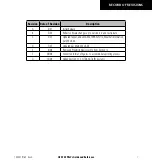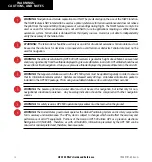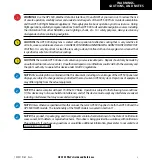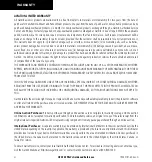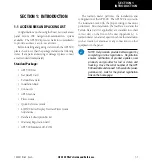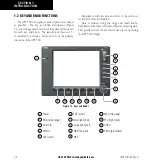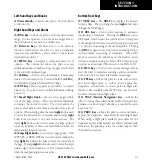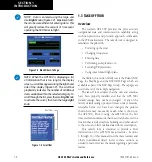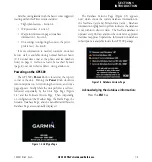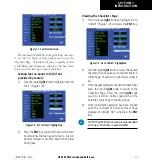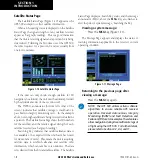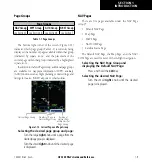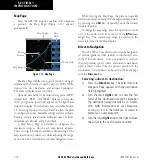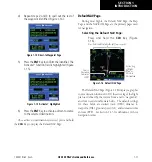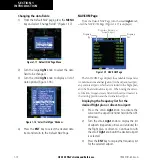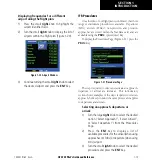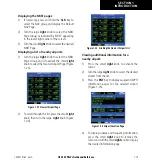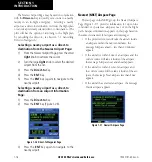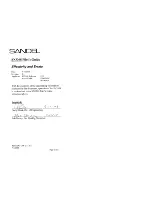
GPS 500 Pilot’s Guide and Reference
1-3
SECTION 1
INTRODUCTION
190-00181-60 Rev. G
Left-hand Keys and Knobs
(1) Power Knob
–
Controls unit power. Turn clockwise
to turn unit on.
Right-hand Keys and Knobs
(2) RNG Key –
Allows the pilot to select the desired
map
range. Use the up arrow to zoom out to a larger area, or
the down arrow to zoom in to a smaller area.
(3) Direct-to Key –
Provides access to the direct-to
function, which allows the pilot to enter a destination
waypoint and establishes a direct course to the selected
destination (Section 3).
(4) MENU Key –
Displays a context-sensitive list of
options. This options list allows the pilot to access
additional features or make settings changes which relate
to the currently displayed page.
(5) CLR Key –
Used to erase information, remove map
detail, or to cancel an entry. Press and hold the
CLR
key
to immediately display the Default NAV Page.
(6) ENT Key –
Used to approve an operation or complete
data entry. It is also used to confirm information during
power on.
(7) Small Right Knob –
Used to select pages within
one of the page groups. Press this knob momentarily
to display the on-screen cursor. The cursor allows the
pilot to enter data and/or make a selection from a list of
options. When entering data, the small
right
knob is used
to select the desired letter or number and the large
right
knob is used to move to the next character space. The
small
right
knob is also used to move the target pointer
up (turn clockwise) or down (counterclockwise) when the
map panning function is active.
(8) Large Right knob –
Used to select page groups: NAV,
WPT, AUX, or NRST. With the on-screen cursor enabled, the
large
right
knob allows the pilot to move the cursor about
the page. The large
right
knob is also used to move the target
pointer right (turn clockwise) or left (counterclockwise)
when the map panning function is active.
Bottom Row Keys
(9) NRST Key –
The
NRST
Key displays the Nearest
Airports Page. Then, turning the small
right
knob steps
through the NRST pages.
(10) OBS Key –
Used to select manual or automatic
sequencing of waypoints. Pressing the
OBS
Key selects
OBS mode, which retains the current ‘active to’ waypoint
as the navigation reference even after passing the waypoint
(i.e., prevents sequencing to the next waypoint). Pressing
the
OBS
Key again returns the unit to normal operation,
with automatic sequencing of waypoints. When OBS
mode is selected, the pilot may set the desired course
to/from a waypoint using the Select OBS Course pop-up
window, or an external OBS selector on the HSI or CDI.
(11) MSG Key –
Used to view system
messages and to
alert the pilot to important warnings and requirements.
See Section 14.1 for more information on
messages.
(12) FPL Key –
Allows the pilot to create, edit, activate,
and invert flight plans, as well as access approaches,
departures, and
arrivals. A closest point to flight plan
feature is also available from the FPL Key. See Section 4
for more information on flight plans.
(13) VNAV (Vertical Navigation) Key –
Allows the
pilot to create a three-dimensional profile which provides
guidance to a final (target) altitude at a specified location
See Section 9.
(14) PROC Key –
Allows the pilot to select and remove
approaches, departures, and arrivals from the flight plan.
When using a flight plan, available procedures for the
departure and/or arrival airport are offered automatically.
Otherwise, the pilot may select the desired airport, then
the desired procedure.
Summary of Contents for GPS 500
Page 1: ...GPS 500 Pilot s Guide and Reference ...
Page 2: ......
Page 72: ...GPS 500 Pilot s Guide and Reference 4 16 SECTION 4 FLIGHT PLANS Blank Page 190 00181 60 Rev G ...
Page 98: ...GPS 500 Pilot s Guide and Reference SECTION 5 PROCEDURES 5 26 Blank Page 190 00181 60 Rev G ...
Page 134: ...GPS 500 Pilot s Guide and Reference 7 12 SECTION 7 NRST PAGES Blank Page 190 00181 60 Rev G ...
Page 255: ......



